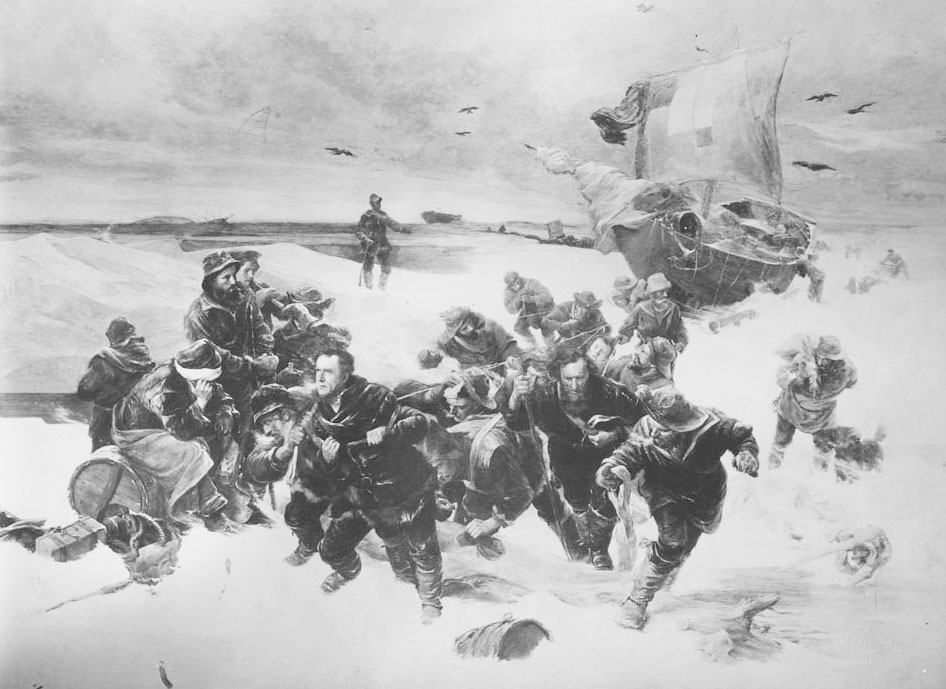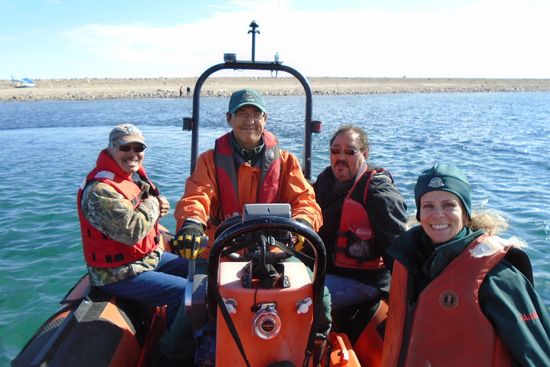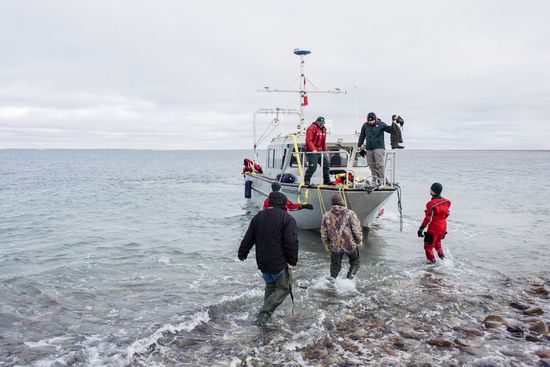
Crew of the Franklin Expedition hauls a boat over Arctic ice after abandoning the ships HMS Erebus and HMS Terror and heading southward to look for provisions. [Sir Julius V. Payer/LAC/MIKAN 3211475]
Buried on page 328, the piece began with a poem that ends with the wish that “after years you have perchance to roam, that science crown’d you safely seek your home!”
The chronicle’s wishes for success and a safe return were likely never conveyed to the 134 crew members of HMS Erebus and HMS Terror. They had left the previous Monday from Greenhithe on the River Thames east of London and most would never see their homes again. (Five disembarked at Greenland.)
Indeed, it would be more than a century-and-a-half before any white man—aside from the ships’ complement (which included at least four women) and the crew of a whaling vessel encountered en route—would cast eyes on her majesty’s ships again.

Heading to the HMS Erubus wreck site in 2015 are (from left) Jacob Keanik of the Nattilik Heritage Centre, intern Theoran Kopak, historian Louie Kamookak of Gjoa Haven, and Ellen Bertrand of Parks Canada. Kamookak performed a traditional blessing to honour his ancestors and the lost members of the Franklin Expedition. [Parks Canada]
The fabled, ill-fated Franklin Expedition is a cornerstone of Canadian lore. The story of the ships’ disappearance in the vast expanse of snow and ice that defines what is now the Canadian Arctic stirs the hearts of many Canadians, whose identity and patriotic pride are inextricably linked to the North.
But the technicalities of maritime law cast a different light on Erebus and Terror. Under the International Law of the Sea, military wrecks, however old they may be, remain under the jurisdiction and protection of the nation that lost the ship.

Parks Canada vessel Investigator takes researchers to the wreck site of HMS Erebus. [Parks Canada]
The idea that this epic story would end with the return of the ships and their artifacts to Britain seemed incongruous. Those fears were allayed on Oct. 23, however, when Britain’s defence ministry announced it will transfer ownership of the wrecks to Parks Canada, retaining only a small sampling of artifacts in the process.
“This is extraordinarily important,” said Catherine McKenna, Minister of Environment and Climate Change. “We’re very pleased this is happening.”
Parks Canada archeologists have explored the wrecks and are now preparing a major excavation of Erebus next summer. The department has hired Inuit guardians to watch over the wrecks beginning next year.
The British government will update a 1997 memorandum of understanding that gave Britain ownership of everything related to the wrecks and deemed that Canada would retain custody and control, said British Secretary of State for Defence Michael Fallon.
“This exceptional arrangement will recognize the historical significance of the Franklin Expedition to the people of Canada, and will ensure that these wrecks and artifacts are conserved for future generations,” said Fallon.
Most of the artifacts are expected to stay in Canada, although human remains or any gold bullion would go back to Britain, said McKenna, adding that Canada is committed to joint ownership of the wrecks and their artifacts with the Inuit, whose oral history references sightings of Franklin crew.
“The discovery of HMS Erebus and HMS Terror would not have been possible without Inuit knowledge,” said a statement from Parks Canada.
During a dive on Terror in April, archeologists observed at least four anchors still attached to the vessel, a small boat on the seabed off her port stern quarter, and her bell, which had fallen from its belfry support and lies partly on the ship’s deck.
The wrecks are now designated national historic sites under Environment Canada jurisdiction.
Originally designed as sail-powered naval mortar bomb vessels, Erebus and Terror were refitted and strengthened for arctic service. That included iron sheathing at their bows. Each was also equipped with a 20-horsepower steam engine and a single-screw propeller capable of four knots. Before they fell victim to snow and ice, they carried equipment to conduct zoological, botanical, magnetic and geological surveys.
“The arrangements made for the comfort of the officers and crews are excellent,” reported The Illustrated London News. “The quantity of stores taken on board is considerable, and consists of preserved provisions of various kinds, a large quantity of tea, and extra strong West Indian rum, 35 per cent overproof…. The consumption is thus provided for a prolonged expedition.”
The Barretto, a transport ship, was hired to carry 10 “fine live oxen.” “She will accompany the discovery vessels to the edge of the ice, and these animals may then be killed, and their flesh preserved fresh for any length of time,” the article said.
Erebus and Terror were also supplied with 200 tin cylinders each. They would hold papers to be thrown overboard, stating the longitude and “other particulars worthy of record” in six different languages. Finders were requested to forward the information to the nearest British Admiralty office—standard practice aboard ships on discovery and hydrographic service.
In 1848, Captain Francis Crozier, serving on his sixth polar expedition, deposited one of these tins in a cairn on King William Island. He had taken command of the expedition after Franklin died the year before.
Inside the tin were two messages made over the previous year that filled a single document to the margins. It was found at Victory Point on King William Island by Lieutenant William Hobson in May 1859. The second message outlined a dire situation:
April 25, 1848. H.M. ships ‘Terror’ and ‘Erebus’ were deserted on the 22nd April. 5 leagues N.N.W. of this, having been beset since 12th September, 1846. The officers and crews, consisting of 105 souls, under the command of Captain F.R.M. Crozier, landed here. Sir John Franklin died on the 11th June, 1847, and the total loss by deaths in the expedition has been to this date 9 officers and 15 men.
Before abandoning the ships and heading southward, Crozier and his exhausted crew, suffering from scurvy and starvation, discarded clothing, blankets, a cook stove, ropes, a sextant and a medical chest. Items were still strewn about the campsite when it was found after being described by an Inuk in 1879.
Subsequent expeditions would find relics and graves with mummified remains of Franklin crew members, but no ship’s log. No survivors were ever found, and the fate of Crozier and the others remains a mystery to this day.
Advertisement





















